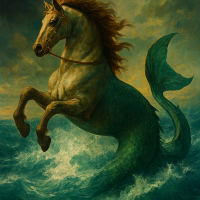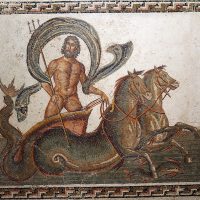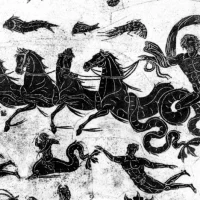Hippocampus : The Original Seahorse
Listen
At a glance
| Description | |
|---|---|
| Origin | Mediterranean Mythology |
| Classification | Hybrids |
| Family Members | N/A |
| Region | Greece, Cyprus, Italy, Lebanon, Turkey |
| Associated With | Poseidon |
Hippocampus
Introduction
The Hippocampus, a mythical creature that combines the strength of a horse with the grace of the sea, holds an important place in Greek, Roman, and Phoenician mythology. Its name comes from the Greek words hippos meaning horse and kampos meaning sea monster. The Hippocampus is often depicted as a divine being that connects the realms of land and sea. It is most closely associated with Poseidon, the Greek god of the ocean, whose chariot was said to be pulled by these majestic sea-horses. Over time, the Hippocampus has become a powerful symbol of balance, transformation, and the mysterious beauty of the natural world.
Physical Traits
The Hippocampus is described as having the front half of a horse and the tail of a fish or dolphin. Its upper body includes a strong neck, a noble head, and flowing mane, while its lower half ends in a curling, scaly tail that allows it to glide through the water. Ancient Greek and Roman art often portrayed the Hippocampus with shimmering scales, fin-like wings, and long, coiled tails that resembled waves. The creature was painted in shades of green, blue, and silver, reflecting the light and motion of the sea. In some Phoenician and Etruscan versions, the Hippocampus was shown with wings, suggesting its divine ability to move between different realms. The shape of the creature later inspired the scientific name of the modern seahorse, whose curled body reminded early scientists of the mythical sea-horse.
Family
In mythology, the Hippocampus is most famously associated with Poseidon, who ruled the seas and commanded storms. These creatures were believed to pull his golden chariot across the ocean’s surface, their powerful tails slicing through waves like galloping horses on land. Artistic depictions often show Poseidon surrounded by hippocampi, dolphins, and tritons, creating an image of perfect harmony between land and sea. The Hippocampus also served other sea deities, including Amphitrite, Poseidon’s consort, and Triton, his messenger. In Roman mythology, Neptune, the counterpart of Poseidon, was similarly depicted with hippocampi drawing his chariot in mosaics and sculptures. In Phoenician tradition, the Hippocampus was linked to Melqart, the god of the sea and navigation. Coins from ancient Tyre show Melqart riding a winged Hippocampus, symbolizing divine protection for sailors and merchants. Through these depictions, the Hippocampus came to represent loyalty, power, and guidance across dangerous waters.
Other names
The creature is known by several names in different traditions. In Greek, it was called Hippokampos (ἱππόκαμπος), while the Romans used the Latinized Hippocampus. The plural form, Hippokampoi, referred to groups of these sea-horses, often shown pulling divine chariots. In English, the term “sea-horse” was sometimes used to describe the Hippocampus in poetic texts, though it should not be confused with the small marine animal that bears the same name. Across the Mediterranean, similar hybrid creatures were imagined by blending various animals with fish, resulting in names such as Aigikampos (goat-fish) and Taurokampos (bull-fish). These names reveal how widespread the idea of combining land and sea animals was in ancient mythology. Over time, the word Hippocampus was also adopted in science to describe a part of the human brain whose shape resembles that of a seahorse, linking ancient legend with modern anatomy.
Powers and Abilities
As mythological beings, hippocampi were thought to possess incredible strength and supernatural abilities. They were capable of swimming at great speeds, guiding gods and mortals safely through the sea. Their bodies were perfectly adapted to both water and air, and they were often seen as guardians of sailors, protecting ships from storms and shipwrecks. Some legends describe them as creatures that could sense danger in the ocean and alert seafarers before disasters occurred. In a few myths, they were said to have the power to transform their tails into legs, allowing them to move clumsily on land, though their true home was always the water. The Hippocampus represented adaptability, courage, and the unity of different elements. Its presence beside Poseidon and Neptune also symbolized divine control over nature and the harmony between land, sea, and sky.
Modern Day Influence
The influence of the Hippocampus continues in modern times, appearing in both science and popular culture. In neuroscience, the term hippocampus refers to a curved structure within the human brain that is essential for memory formation and learning. Scientists named it for its resemblance to a seahorse, continuing the link between mythology and discovery. In art, architecture, and literature, the Hippocampus remains a popular symbol of creativity and transformation. Sculptures and fountains in coastal cities often feature hippocampi as guardians of water, while fantasy literature and games continue to reinvent the creature.
The Hippocampus appears in stories such as Percy Jackson and the Olympians, where it serves as a loyal companion to demigods, and in video games like World of Warcraft and Age of Mythology, where it is depicted as a majestic sea steed. It also appears in animated shows and films like Harry Potter and The Little Mermaid, embodying beauty, grace, and intelligence. Beyond entertainment, the Hippocampus is used in heraldry and naval emblems, symbolizing strength, navigation, and protection at sea. In art and design, it represents imagination and fluidity, qualities that link human creativity to the mysteries of the ocean.
From mythology to neuroscience, the Hippocampus remains a bridge between ancient belief and modern knowledge. Its story endures as a reminder of how myth and science often share the same desire to understand and celebrate the wonders of the natural world.
Related Images
Source
Adam Mercer. (2024). The Hippocampus in Ancient Egypt. Egypt Manchester Museum Blog. https://egyptmanchester.wordpress.com/2024/10/31/the-hippocampus-in-ancient-egypt/
History Cooperative. (2025). Hippocampus in Greek Mythology: The Mysterious Sea Horse. https://historycooperative.org/hippocampus-mythology/
Mythologica Encyclopedia. (2024). The Hippocampus. https://mythologicaencyclopedia.com/hippocampus/
Ancient Literature. (2022). Hippocampus Mythology: The Mythical Benevolent Sea Guardian. https://ancient-literature.com/hippocampus-mythology/
Greek Mythology Tours. (n.d.). Best Percy Jackson Mythological Creatures. https://greekmythologytours.com/blog/percy-jackson/percy-jackson-mythological-creatures
Duque-Colorado, J. (2025). Hippocampus and cornu ammonis: mythonyms that prevail in neuroscience. Frontiers in Neuroanatomy, 19, e12003425. https://pmc.ncbi.nlm.nih.gov/articles/PMC12003425/
Anand, K. S., & Dhikav, V. (2012). Hippocampus in health and disease: An overview. Annals of Indian Academy of Neurology, 15(4), 239–246. https://pmc.ncbi.nlm.nih.gov/articles/PMC3548359/
Wikipedia. (n.d.). Hippocampus (mythology). https://en.wikipedia.org/wiki/Hippocampus_(mythology)[1]
Ogden, D. (2013). Dragons, Serpents, and Slayers in the Classical and Early Christian Worlds. Oxford University Press.
Boardman, J. (1998). Greek Art. Thames & Hudson.
Markoe, G. (2000). Phoenicians. University of California Press.
Littleton, C. S. (2002). Gods, Goddesses, and Mythology. Marshall Cavendish.
Lurker, M. (1987). The Routledge Dictionary of Gods and Goddesses, Devils and Demons. Routledge.
Frequently Asked Questions
What is lorem Ipsum?
I am text block. Click edit button to change this text. Lorem ipsum dolor sit amet, consectetur adipiscing elit. Ut elit tellus, luctus nec ullamcorper mattis, pulvinar dapibus leo.
What is lorem Ipsum?
I am text block. Click edit button to change this text. Lorem ipsum dolor sit amet, consectetur adipiscing elit. Ut elit tellus, luctus nec ullamcorper mattis, pulvinar dapibus leo.
What is lorem Ipsum?
I am text block. Click edit button to change this text. Lorem ipsum dolor sit amet, consectetur adipiscing elit. Ut elit tellus, luctus nec ullamcorper mattis, pulvinar dapibus leo.
What is lorem Ipsum?
I am text block. Click edit button to change this text. Lorem ipsum dolor sit amet, consectetur adipiscing elit. Ut elit tellus, luctus nec ullamcorper mattis, pulvinar dapibus leo.
What is lorem Ipsum?
I am text block. Click edit button to change this text. Lorem ipsum dolor sit amet, consectetur adipiscing elit. Ut elit tellus, luctus nec ullamcorper mattis, pulvinar dapibus leo.










